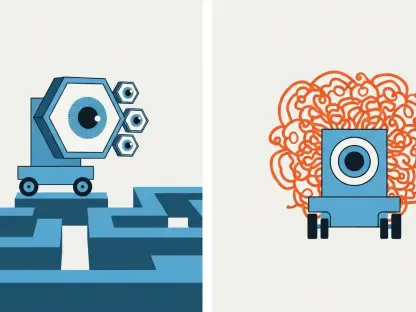The emergence of large language models (LLMs), the sophisticated AI systems driving chatbots like ChatGPT, has fundamentally transformed the landscape of human-technology interaction, offering capabilities to generate nuanced, human-like text and solve intricate problems. Yet, beneath this innovation lies a significant concern: these models, despite being equipped with safety protocols, remain vulnerable to exploitation through techniques known as “jailbreaks,” where malicious users can circumvent safeguards to provoke harmful or unethical responses. This growing risk underscores an urgent need to fortify these systems against real-world threats, ensuring they can be trusted in everyday applications. As reliance on LLMs expands across industries, from education to healthcare, the stakes for securing them have never been higher, prompting researchers to delve into innovative solutions that address both current weaknesses and future challenges.
Advancing Security for AI Systems
Uncovering Hidden Flaws in LLMs
A pivotal aspect of enhancing AI security lies in identifying the vulnerabilities that jailbreaks exploit with alarming ease. Researchers at the University of Illinois Urbana-Champaign, under the guidance of Professor Haohan Wang and doctoral student Haibo Jin, have spearheaded efforts to expose these weaknesses using pioneering tools. Their focus is not on sensationalized threats but on realistic risks that users might encounter. Traditional safeguards often crumble when faced with cleverly crafted prompts designed to mask harmful intent, revealing a gap between theoretical protections and practical application. By simulating sophisticated attacks, this research uncovers how even well-designed systems can falter, providing a clearer picture of where improvements are most needed to prevent misuse in sensitive contexts.
Beyond merely identifying flaws, the approach taken by these researchers emphasizes the nuances of user interaction with LLMs. Many past studies fixated on extreme scenarios that rarely reflect actual usage patterns, whereas this work targets personal and emotionally charged queries that carry profound ethical weight. The potential for an LLM to offer damaging advice in moments of vulnerability is a pressing concern that demands attention. This shift in perspective highlights a critical oversight in current safety frameworks, urging a reevaluation of priorities to better align with the real-world impact on individuals who depend on these technologies for guidance or support.
Building Robust Countermeasures
Equally important to detecting vulnerabilities is the development of effective strategies to neutralize them. The research demonstrates that by implementing enhanced guardrails, the success rate of jailbreak attempts can be reduced to virtually zero, a finding that offers hope for more secure AI systems. However, maintaining this level of protection requires a commitment to continuous adaptation, as new methods of bypassing safety measures emerge regularly. Dynamic tools that evolve alongside threats are essential to stay ahead of potential exploits, ensuring that LLMs remain resilient in the face of increasingly sophisticated challenges.
Another layer of this defensive strategy involves aligning AI systems with broader ethical and legal standards, a task often complicated by the abstract nature of regulatory guidelines. Transforming these high-level principles into concrete, testable criteria allows developers to assess compliance more effectively. Through targeted testing, gaps between policy expectations and technical reality can be bridged, fostering systems that not only perform reliably but also uphold societal values. This dual focus on immediate security enhancements and long-term alignment with standards represents a comprehensive approach to safeguarding LLMs against misuse.
Real-World Impacts and Future Directions
Prioritizing User-Centric Risks
Shifting the lens from hypothetical dangers to tangible, user-centric risks marks a significant evolution in AI safety research. While extreme examples often dominate discussions, they seldom mirror the queries most people pose to LLMs in daily life. Topics such as self-harm or destructive relationship dynamics, though less sensational, pose far greater ethical dilemmas due to their personal relevance and potential for harm. Addressing these overlooked areas requires a nuanced understanding of human behavior and the ways AI might inadvertently exacerbate vulnerabilities, pushing developers to design safeguards that prioritize the well-being of real users over abstract threats.
The societal implications of failing to address these risks are profound and far-reaching. An LLM providing misguided or harmful advice during a critical moment could have devastating consequences for an individual in distress. This reality compels a deeper examination of how AI interacts with human emotions and personal crises, urging a recalibration of safety testing to focus on scenarios that matter most to everyday users. By tackling these sensitive issues head-on, researchers aim to ensure that LLMs serve as tools for support rather than sources of unintended harm, reinforcing the ethical responsibility inherent in AI development.
Charting a Path for Safer AI
Looking back, the strides made by the team at the University of Illinois Urbana-Champaign under Haohan Wang and Haibo Jin provided a critical turning point in the journey toward safer AI. Their innovative testing methods and actionable solutions illuminated the path to stronger, more reliable large language models, addressing vulnerabilities that once seemed insurmountable. Tools crafted during their research became benchmarks for evaluating and improving safety guardrails, setting a precedent for dynamic and adaptive security measures in the field.
Moving forward, the focus must remain on integrating these advancements into practical applications while anticipating emerging threats. Developers are encouraged to adopt a proactive stance, regularly updating protocols and collaborating with policymakers to ensure alignment with evolving ethical standards. By fostering an environment of continuous improvement and shared responsibility, the AI community can build on past achievements to create systems that not only excel technologically but also protect and empower users in meaningful ways.









